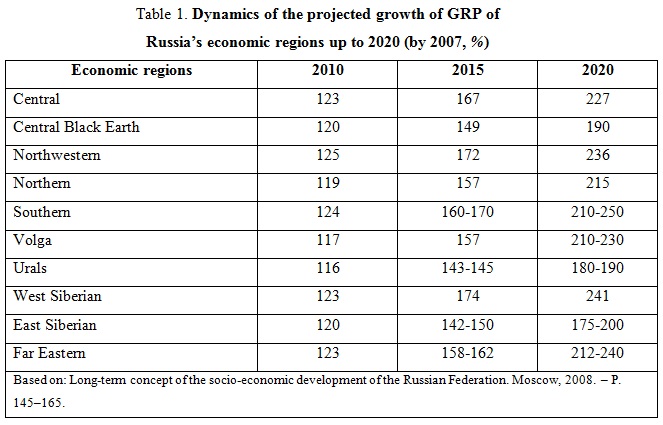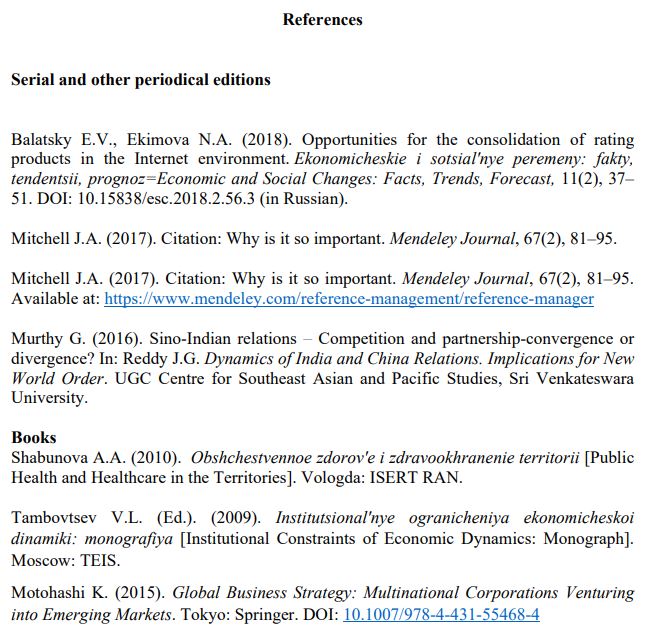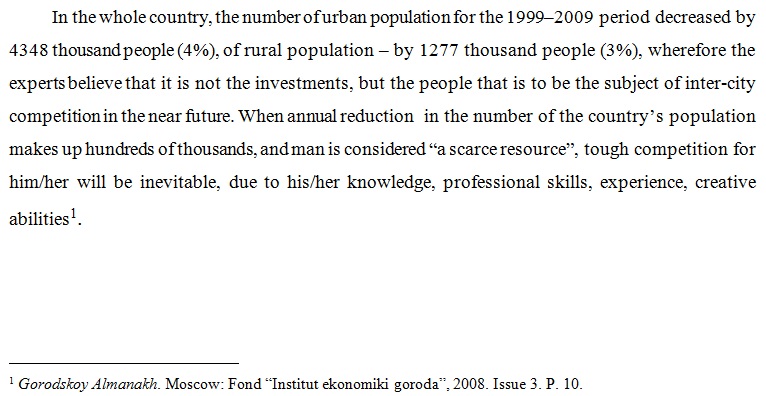Author guidelines
The requirements for submission of manuscripts to the editorial staff of the scientific journal Economic and Social Changes: Facts, Trends, Forecast
- General information
- Requirements to the package of materials
- Requirements to the content and structure of articles
- Text design requirements
- Examples of how parts of an article should be arranged
General information
The Journal publishes original theoretical and experimental articles which correspond to the remit of the Journal. The manuscript should be of no less than 16 pages (30,000 characters with spaces). The maximum length of the paper submitted to publication is 25 pages (50,000 characters with spaces). Book reviews, information on scientific conferences, scientific chronicles are also submitted to publication. The papers should contain research findings of completed and methodologically proper works.
The decision for publication is made by the editor on the basis of the reviewer’s report. The novelty, scientific importance and relevance of submitted materials are also taken into consideration. Articles rejected by the editor will not be re-considered.
The journal does not charge any fees for considering and reviewing manuscripts. However, for Russian authors there is a fee for translation of their manuscripts into the English language. It allows to ensure high-quality unified translation of materials; the corresponding services are paid at the rate of 550 rubles per page (1800 characters) of the final version of the text. Payment for the transfer is carried out only after passing the scientific review and approval of the article by the editorial board of the journal for printing in the next issue.
Requirements to the package of materials
The following materials are submitted to the editor in electronic form:
- A file with an article in the Microsoft Word format with .docx. The name of the file must be written in Latin with the author’s name (e.g., Ivanova.docx).
- A separate page with the full information about the author: full name, academic degree and title, place of work and position, contact information (postal address, telephone, e-mail – if available), ORCID ID, Researcher ID arranged according to the sample (Appendix 1).
- A scanned copy of the commitment of the author not to publish the article in other publications (Appendix 2).
- A color photo of the author in the .jpeg / .jpg format of no less than 1 MB.
The materials in electronic form are sent to the e-mail address of the editor (esc@volnc.ru).
Requirements to the content and structure of articles
All scientific articles submitted to the editor should substantially meet the following requirements.
The structure of the article must correspond to the international IMRAD standard, i.e. it must contain the following sections: introduction, description of research methodology and its justification, research results description, analysis and explanation of the obtained research results, discussion of research results (O.V. Kirillova (Ed.). Metodicheskie rekomendatsii po podgotovke i oformleniyu nauchnykh statei v zhurnalakh, indeksiruemykh v mezhdunarodnykh naukometricheskikh bazakh dannykh [Guidelines for preparation and design of scientific articles in journals indexed in international scientometric databases]. Association of Science Editors and Publishers. Moscow, 2017. 144 p. (Appendix).
The introductory part contains a clearly defined research purpose, substantiates scientific novelty and significance of the research, and contains analysis of contemporary literature available on the subject (monographs, articles, methodological recommendations, etc. published as a rule in the latest 3–5 years). It is expected that this analysis is of a problematic nature, i.e. the article does not just enumerate the existing works on the subject, but provides the author’s vision of the research already conducted by other scientists, the advantages and disadvantages of these papers as connected to the subject of the research conducted by the author and reflected in the article, so that the scientific novelty of the author’s work is clearly seen.
The article should be polemical and it should encourage discussion, that is, the material is presented in such a way that the readers (specialized scientists, employees of public authorities, etc.) would like to participate in the discussion of the issues raised, and express their opinion (an example of an article, the content of which is polemical and encouraging discussion, is the work by Doctor of Sciences (Economics), Professor S.S. Gubanov “Neo-Industrial Development Model and Its System Algorithm” published in the journal Economic and Social Changes: Facts, Trends, Forecast, 2014, issue 3 (33)).
The final part should contain a detailed, reasoned substantiation of the importance of the conducted scientific research and reflected in the work. The author should specify what kind of contribution to the development of theoretical and applied science their work makes.
The list of references includes key relevant fundamental studies of major domestic and foreign scientists, as well as the works reflecting the current status of science on this research subject.
The title of the article corresponds to its content and is of problematic nature. It reflects the subject category and contains basic key words.
The title of the article must be brief and informative: it must clearly reflect its content in few words. Use of abstract words such as “research”, “study”, “observation”, “important”, “significant” etc. is not recommended. It is also not recommended to include terms which are not used in international scientific research (including author’s terms), as well as abbreviations (except for the generally accepted ones) and formulas.
In case the article contains the results of sociological studies, the following data are to be included: methodology and method information; date, place (territory) and organization that carried out the research; finite population structure; sample type, sample volume, sample error; description of method for data acquisition and analysis. This information is presented in one of the following ways: in a special section (paragraph) of the article; directly in the text; in a footnote. When drawing up tables it is important to clarify how percentage is calculated: of the number of respondents to this question or of the total number of respondents.
The authors must be registered in ORCID system and have relevant IDs. Guidelines for using ORCID system are available here.
Text design requirements
-
Margins
Right – 1 cm, others – 2 cm.
-
Font
Font size – 14, type – Times New Roman (in case a special type font is needed, when typing Greek, Arab, etc. words, Windows default fonts are to be used). In case the paper contains seldom used fonts, they (font family) are to be submitted along with the file. Line space – 1,5.
-
Indent – 1.25. Made automatically in MS Word.
-
Numbering
Page numbers are placed in the lower right corner of the page automatically with the use of MS Word tools.
-
First page of the article
In the upper right corner, the UDC is placed, under it, after the 1.5 spacing – the LBC, then – the symbol ©, indent (spacing), and the name and initials of the author in semi-bold. After the 2-spacing indent, the title of the article is given. Central alignment is used for the title of the article given in lowercase letters in semi-bold. The abstract and key words are given below, after the 2-spacing indent, without a paragraph indent, in italics and aligned by width. Then, after the 2-spacing indent, the text of the article is placed.
-
Abstract
The abstract contains from 200 to 250 words.
The abstract is an independent text arranged in one paragraph and acting as the brief model of the article. The abstract reflects the relevance of the research, the main idea and the goal of the research, briefly states its undoubted scientific novelty and its differences from similar works of other scientists; it specifies methods used by the author and the main research findings of the work performed; it identifies areas of application of the results of the study and briefly formulates the prospects for further research in this area.
Examples of good abstracts for different types of articles (reviews, scientific articles, conceptual articles, application articles) are available at: http://www.emeraldinsight.com/authors/guides/write/abstracts.htm?part=2&PHPSESSID=hdac5rtkb73ae013ofk4g8nrv1.
-
Key words
Each article must contain key words (up to 8 words or phrases). They must fully reflect the content of the article. The maximum number of words within a key phrase – 3.
-
Tables
In the title of the table, the word “Table” and its number are not highlighted in bold. The headline is given in bold, and is center aligned (see Appendix 3).
The tables are inserted, drawing tools and AutoShapes are not allowed; column and cell alignment using spaces or tabs is not allowed. MS WORD table editor is used for tables. Each piece of data of the stub and head of the table correspond to discrete cell. Only editor standard tools are applied for creating and formatting tables, no pilcrows, spaces and extra blank lines for semantic breakdown and line adjustment are allowed.
-
Figures (schemes, graphs, diagrams)
The caption and its number are placed below the figure. The word “Figure” is in normal font, without highlighting). The caption runs in bold, center alignment, single-spaced (see Appendix 4).
MS EXCEL is to be used for creating charts, MS WORD, MS VISIO – for flow charts, MS Equation – for formulas.
Figures and charts created in MS WORD are to be grouped within one single object. Graphic materials that are scanned, exported, or taken from the Internet are not allowed in the article.
Algorithm of charts insertion from MS EXCEL to MS WORD:
- select the chart in MS EXCEL using the mouse, right click and select “copy” from the list of options;
- in MS WORD right-click, select “paste” from the list of options, click on “paste special”, “Microsoft Excel chart”.
-
Bibliographic description of the sources under tables and figures
Write: either “Source”, or “Compiled with the use of”, or “Calculated with the use of”, etc., after that – information about the source (Appendix 3).
-
Page footnotes
Page footnotes are executed according to GOST Р 7.0.5.– 2008 (Appendix 6).
-
References
The word “References” is given after a 1.5 spacing after the body of the article in lowercase letters, semi-bold italics, center alignment. Then, the numbered list of references is given after the 1.5 spacing.
The sources are arranged alphabetically: Russian-language sources go first, then – English-language sources.
In case the paper has a DOI, it is given in the References.
References to Russian-language sources are given in accordance with GOST 7.0.5 – 2008. References to English-language sources are given according to the Harvard standard (Information about the modified Harvard standard is given in the book: Kirillova O.V. Redaktsionnaya podgotovka nauchnykh zhurnalov po mezhdunarodnym standartam: rekomendatsii eksperta BD Scopus [Editorial Preparation of Scientific Journals according to International Standards: Recommendations of a Scopus Expert]. Moscow, 2013. Part 1. 90 p.) (see Appendix 5).
The list of references contains links to scientific works used by the author in the preparation of the article. It is obligatory that the author provides links to all the sources from the list of references in the body of the article.
In accordance with international publishing standards, the recommended number of sources in the References should be at least 20, of which at least 30% should be foreign sources.
The number of references to the author’s works should not exceed 10% of the total number of references given in the list.
It is not recommended to include the following sources in the list of references:
- articles from any non-scientific magazines and newspapers;
- regulatory and legislative acts;
- statistical compilations and archival materials;
- sources without attribution of the author (for example, collections under someone’s editorship);
- dictionaries, encyclopedias, other reference books;
- reports, records, memos, protocols;
- textbooks, etc.
It is recommended to provide the corresponding page footnotes for these sources.
It is recommended to include the following sources in the list of references:
- articles from printed scientific journals (or electronic versions of printed scientific journals);
- books;
- monographs;
- published conference proceedings;
- patents.
A reference to the bibliographic source in the body of the article is given in parentheses indicating the author’s surname and the year of publication. It is possible to make reference to multiple sources from the list, which should be separated by a semicolon (for example: (Ivanov, 2020), (Ivanov, 2020; Petrov, 2018), etc.).
Poor quality of the references can result in the rejection of the manuscript.
Poor quality” of the references, from the point of view of the editor, means that
- there are errors in the description of the sources, or lack of the information required;
- there are too many references to little-known or hard-to-reach sources;
- there are references to unpublished works;
- there are references to the sources that contain an incomplete text of the article or monograph;
- there is excessive self-citation;
- there are references to non-scientific sources.
Please note that the articles that do not have the complete package of accompanying documents and the articles that do not comply with the publisher’s requirements are not accepted.
Examples of how parts of an article should be arranged
Appendix 1
Table 1. Information about the author
| Full name | |
| Place of residence (city, town, etc.) | |
| Country | |
| Place of residence (city, town, etc.) | |
| Country | |
| Academic degree | |
| Academic rank | |
| Academic degree | |
| Academic rank | |
| ORCID ID | |
| Researcher ID | |
| Full name of organization – place of employment (in case there is more than one place of employment, all of them should be given) | |
| Mailing address of the place of employment (for each organization) | |
| Position (in each organization) | |
| E-mail (for publication) | |
| Not for publication | |
| Age | |
| Education | |
| Phone/ Fax (work) | |
| Phone/ Fax (personal) | |
| E-mail (work | |
| E-mail (personal) | |
| Mailing address (place of residence) | |
Appendix 2
OBLIGATION
I,___________________________________,
full name, position and place of employment
hereby certify that the article
“___________________________________”
title of article
has never been published and is not currently being considered by any publishing house or editor. I agree not to submit this article for publication in other periodicals or collections of articles prior to its publication in the journal Economic and Social Changes: Facts, Trends, Forecast.
Date
Signature
Appendix 3

Appendix 4

Appendix 5

Appendix 6
